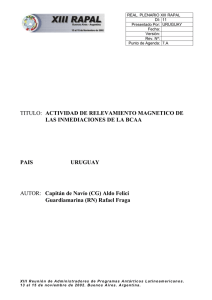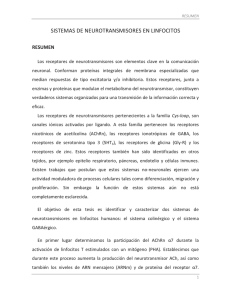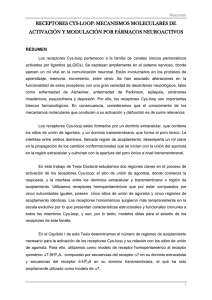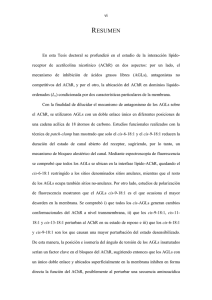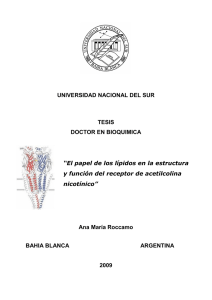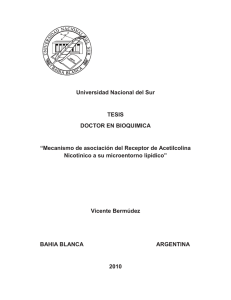Tesis parcial Tolosa, M. F..pdf
Anuncio
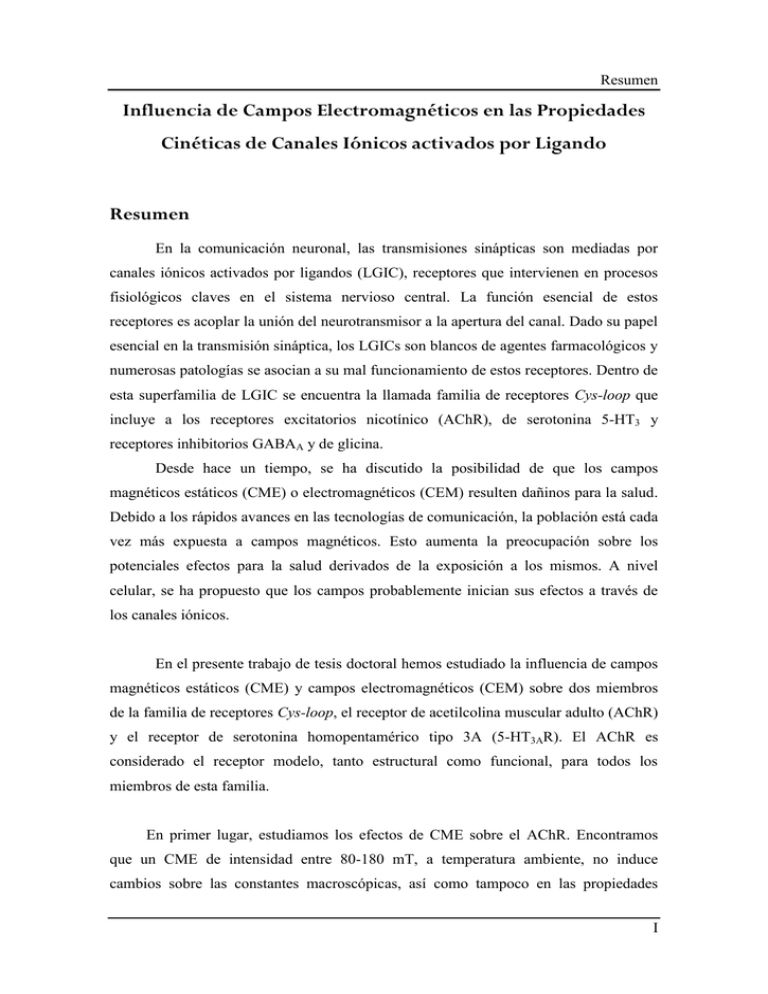
Resumen Influencia de Campos Electromagnéticos en las Propiedades Cinéticas de Canales Iónicos activados por Ligando Resumen En la comunicación neuronal, las transmisiones sinápticas son mediadas por canales iónicos activados por ligandos (LGIC), receptores que intervienen en procesos fisiológicos claves en el sistema nervioso central. La función esencial de estos receptores es acoplar la unión del neurotransmisor a la apertura del canal. Dado su papel esencial en la transmisión sináptica, los LGICs son blancos de agentes farmacológicos y numerosas patologías se asocian a su mal funcionamiento de estos receptores. Dentro de esta superfamilia de LGIC se encuentra la llamada familia de receptores Cys-loop que incluye a los receptores excitatorios nicotínico (AChR), de serotonina 5-HT3 y receptores inhibitorios GABAA y de glicina. Desde hace un tiempo, se ha discutido la posibilidad de que los campos magnéticos estáticos (CME) o electromagnéticos (CEM) resulten dañinos para la salud. Debido a los rápidos avances en las tecnologías de comunicación, la población está cada vez más expuesta a campos magnéticos. Esto aumenta la preocupación sobre los potenciales efectos para la salud derivados de la exposición a los mismos. A nivel celular, se ha propuesto que los campos probablemente inician sus efectos a través de los canales iónicos. En el presente trabajo de tesis doctoral hemos estudiado la influencia de campos magnéticos estáticos (CME) y campos electromagnéticos (CEM) sobre dos miembros de la familia de receptores Cys-loop, el receptor de acetilcolina muscular adulto (AChR) y el receptor de serotonina homopentamérico tipo 3A (5-HT3AR). El AChR es considerado el receptor modelo, tanto estructural como funcional, para todos los miembros de esta familia. En primer lugar, estudiamos los efectos de CME sobre el AChR. Encontramos que un CME de intensidad entre 80-180 mT, a temperatura ambiente, no induce cambios sobre las constantes macroscópicas, así como tampoco en las propiedades I Resumen cinéticas a nivel de canal único. Dado que las propiedades diamagnéticas de la membrana celular se modifican por encima de una temperatura crítica, se realizaron estudios electrofisiológicos en un rango de temperatura de 5 °C a 50 °C, donde encontramos nuevamente que los LGIC no son sensibles a CME a otras temperaturas. En segundo lugar, caracterizamos la influencia del CEM sobre los AChR y 5HT3AR. Los ensayos electrofisiológicos de corrientes macroscópicas mostraron que la amplitud de corriente disminuye en función de la frecuencia del CEM aplicado. La constante de decaimiento temporal no resulta modificada, mientras que el tiempo de activación aumenta significativamente. A nivel de canal único, encontramos que la exposición a los CEM no afecta la amplitud ni las constantes cinéticas de apertura y cierre. Sin embargo la frecuencia de episodios de activación (clusters), disminuye en función de la frecuencia. Es decir, que la presencia del CEM induce un nuevo estado no conductor, resultando en la disminución del pico de corriente y de la frecuencia de eventos de activación de clusters. Si bien los cambios cualitativos del CEM fueron equivalentes para AChR y 5HT3AR, el receptor 5-HT3A mostró mayor sensibilidad a los efectos del campo. El trabajo desarrollado en esta tesis revela que los CEM pueden modificar la actividad de LGIC y abre puerta para entender los mecanismos moleculares y bases estructurales por los cuales los CEM modifican éstos receptores. II Summary Influence of Electromagnetic Fields on Kinetics Properties of Ligand-gated Ion Channels Summary In neuronal communication, synaptic transmission is mediated by Ligand-Gated Ion Channels (LGICs), which are involved in fundamental physiological processes in the central nervous system. The essential function of these receptors is to couple neurotransmitter binding to channel opening. Given its essential role in synaptic transmission, the LGICs are targets of pharmacological agents and many diseases are associated with their incorrect function. The Cys-loop receptor family belongs to the LGIC superfamily and it includes the excitatory receptors, nicotinic and serotonin 5HT3, and inhibitory receptors, GABAA and glycine receptors. For a while, it has been discussed the possibility that static magnetic fields (SMF) or electromagnetic (EMF) result harmful to health. Due to the rapid advances in communication technologies, the public is increasingly exposed to magnetic fields. This has raised concern about potential health effects resulting from exposure to them. At the cellular level, it is has been proposed that magnetic fields probably initiate their effects through ion channels. In the present thesis we studied the influence of static magnetic fields (SMF) and electromagnetic fields (EMF) on two members of the Cys-loop family receptors, the nicotinic acetylcholine receptor (AChR) and the homopentameric serotonin type 3A receptor (5-HT3AR). The AChR has been the structural and functional model for all members of this family. First, we studied the effects of SMF on the AChR. We found that a strong SMF of 80-180 mT, at room temperature, does not induce any changes on macroscopic currents response to the agonist or in the kinetic properties at the single channel level. Since diamagnetic properties of the cellular membrane are modified above a critical temperature, electrophysiological studies were carried out at a temperature range of 5 III Summary °C to 50 °C. Again, we found that the LGIC receptor is not sensitive to SMF at a range of temperatures. Secondly, we characterized the influence of EMF on the AChR and 5-HT3AR. The electrophysiological recordings of macroscopic currents showed that the amplitude of the current decreases as a function of the EMF frequency applied. The temporal decay constant is not modified, whereas the rise time increases significantly. At the single channel level, we found that the exposure to EMF does not affect the amplitude or channel kinetics. However, the frequency of activation episodes elicited by agonist (cluster) is reduced significantly. Thus, the reduction of the peak current together with the frequency of channel suggests that EMF induces and stabilizes a new closed, non conductive state. Receptors not affected, or leaving this state, do not show changes in activation kinetics. The EMF affects the functionality of both AChR and 5-HT3AR being this influence on the 5-HT3AR is steeper that on the AChR. The work in this thesis contributes to understand how the EMF can modify the activity of LGIC and obtain the molecular mechanisms by which EMFs alter the kinetics of these receptors. IV Bibliografía Bibliografía Ahlbom I.C, Cardis E., Green A., Linet M., Savitz D., Swerdlow A. (2001). Review of epidemiologic literature on EMF and Health. Environ health perspect. 6:911-33. Arias H.R., Bhumireddy P., Bouzat C. (2006). Molecular mechanisms and binding site locations for noncompetitive antagonists of nicotinic acetylcholine receptors. Int J Biochem Cell Biol. 38:1254-76. Auerbach A., Akk G. (1998). Desensitization of mouse nicotinic acetylcholine receptor channels. A two-gate mechanism. J Gen Physiol. 112:181-97. Baenzinger J.E., Ryan S.E., Goodreid M.M., Vuong N.Q., Sturgeon R.M., daCosta C.J. (2008). Lipid composition alters drug action at the nicotinic acetylcholine receptor. Mol Pharmacol. 73:880-90. Barrantes F.J., Bermudez V., Borroni M.V., Antollini S.S., Pediconi M.F., Baier J.C., Bonini I., Gallegos C., Roccamo A.M., Valles A.S., Ayala V., Kamerbeek C. (2010). Boundary lipids in the nicotinic acetylcholine receptor microenvironment. J Mol Neurosci. 40:87-90. Bartos M., Corradi J., Bouzat C. (2009). Structural basis of activation of Cys-loop receptors: the extracellular-transmembrane interface as a coupling region. Mol Neurobiol. 40:236-52. Bauréus Koch C.L.M., Sommarin M., Persson B.R.R., Salford L.G., Eberhardt J.L. (2003). Interaction between weak low frequency magnetic fields and cell membranes. Bioelectromagnetics. 24:395-402. Beckstein O., Biggin P.C., Bond P., Bright J.N., Domene C., Grottesi A., Holyoake J., Sansom M.S. (2003). Ion channel gating: insights via molecular simulations. FEBS Lett. 555:85-90. Beckstein O., Sansom M.S. (2006). A hydrophobic gate in an ion channel: the closed state of the nicotinic acetylcholine receptor. Phys Biol. 3:147-59. Blanton M.P., Cohen J.B. (1992). Mapping the lipid-exposed regions in the Torpedo californica nicotinic acetylcholine receptor. Biochemistry. 31:3738-50. Blanton M.P., Cohen J.B. (1994). Identifying the lipid-protein interface of the Torpedo nicotinic acetylcholine receptor: secondary structure implications. Biochemistry. 33:2859-72. Bouzat C. (2012). New insights into the structural bases of activation of Cys-loop receptors. J Physiol Paris. 106:23-33. Bouzat C., Barrantes F., Sine S. (2000). Nicotinic Receptor Fourth Transmembrane Domain: Hydrogen Bonding by Conserved Threonine Contributes to Channel Gating Kinetics. J Gen Physiol 115:663-72. Bouzat C., Bartos M., Corradi J., Sine S.M. (2008). The interface between extracellular and transmembrane domains of homomeric Cys-loop receptors governs open-channel lifetime and rate of desensitization. J Neurosci.28:7808-19. Bouzat C., Bren N., Sine SM. (1994). Structural basis of the different gating kinetics of fetal and adult acetylcholine receptors. Neuron.13:1395-1402. Bouzat C., Gumilar F., Esandi M.C., Sine S.M. (2002) Subunit-selective contribution to channel gating of the M4 domain of the nicotinic receptor. Biophysics J. 82:1920-29. 120 Bibliografía Bouzat C., Gumilar F., Spitzmaul G., Wang H.L., Rayes D., Hansen S.B., Taylor P., Sine S.M. (2004). Coupling of agonist binding to channel gating in an ACh-binding protein linked to an ion channel. Nature. 430:896-900. Bouzat C., Roccamo A.M., Garbus I., Barrantes FJ. (1998). Mutations at lipid-exposed residues of the acetylcholine receptor affect its gating kinetics. Mol Pharmacol. 54:146-53. Bras W., Diakun G.P., Díaz J.F., Maret G., Kramer H., Bordas J., Medrano F.J. (1998). The susceptibility of pure tubulin to high magnetic fields: a magnetic birefringence and x-ray fiber diffraction study. Biophys J. 74:1509-21. Brejc K., van Dijk W.J., Klaassen R.V., Schuurmans M., van Der Oost J., Smit A.B., Sixma T.K. (2001). Crystal structure of an ACh-binding protein reveals the ligand-binding domain of nicotinic receptors. Nature. 411:269-76. Bruneau E., Akaaboune M. (2007). The dynamics of the rapsyn scaffolding protein at individual acetylcholine receptor clusters. J Biol Chem. 282:9932-40. Changeux J., Edelstein S. (2001). Allosteric mechanisms in normal and pathological nicotinic acetylcholine receptors. Curr Opin Neurobiol. 11:369-77. Cheng X., Wang H., Grant B., Sine S.M., McCammon J.A. (2006). Targeted molecular dynamics study of C-loop closure and channel gating in nicotinic receptors. PLoS Comput Biol. 2:e134. Collingridge G.L., Olsen R.W., Peters J., Spedding M. (2009). A nomenclature for ligandgated ion channels. Neuropharmacology. 56:2-5. Corradi J., Gumilar F., Bouzat C. (2009). Single-channel kinetic analysis for activation and desensitization of homomeric 5-HT(3)A receptors. Biophys J. 97:1335-45. Cymes G.D., Grosman C. (2008). Pore-opening mechanism of the nicotinic acetylcholine receptor evinced by proton transfer. Nat Struct Mol Biol. 15:389-96. Davies P.A., Pistis M., Hanna M.C., Peters J.A., Lambert J.J., Hales T.G., Kirkness E.F. (1999). The 5-HT3B subunit is a major determinant of serotonin-receptor function. Nature. 397:359-63. de Pomerai D., Daniells C., David H., Allan J., Duce I., Mutwakil M., Thomas D., Sewell P., Tattersall J., Jones D., Candido P. (2000). Non-thermal heat-shock response to microwaves. Nature. 405:417–18. Dilger J.P., Brett R.S., Poppers D.M., Liu Y. (1991). The temperature dependence of some kinetic and conductance properties of acetylcholine receptor channels. Biochim Biophys Acta. 1063:253-8. Dilger J.P., Liu Y. (1992). Desensitization of acetylcholine receptors in BC3H-1 cells. Pflugers Arch. 420:479-85. D'Inzeo G., Bernardi P., Eusebi F., Grassi F., Tamburello C., Zani B.M. (1988). Microwave effects on acetylcholine-induced channels in cultured chick myotubes. Bioelectromagnetics. 9:363-72. Dougherty D.A. (2007). Cation-pi interactions involving aromatic amino acids. J Nutr. 137:1504S-1508S. Drinker C.K., Thomson R.M. (1921). Does the magnetic field constitute an industrial hazard? J Ind Hyg. 3:117-129. Foster K.R., Glaser R. (2007). Thermal mechanisms of interaction of radiofrequency energy with biological systems with relevance to exposure guidelines. Health Phys. 92:609-20. 121 Bibliografía Franke C., Hatt H., Parnas H., Dudel J. (1991) Kinetic constants of the acetylcholine (ACh) receptor reaction deduced from the rise in open probability after steps in ACh concentration. Biophys J.60:1008-16. Franke C., Parnas H., Hovav G., Dudel J. (1993). A molecular scheme for the reaction between acetylcholine and nicotinic channels. Biophys J. 64:339-56. Funk R.H., Monsees T., Ozkucur N. (2009). Electromagnetic effects - From cell biology to medicine. Prog Histochem Cytochem. 43:177-264. Galt S., Sandblom J., Hamnerius Y., Höjevik P., Saalman E., Nördén B. (1993). Experimental search for combined AC and DC magnetic field effects on ion channels. Bioelectromagnetics. 14:315-327. García A.M., Sisternas A., Hoyos S.P. (2008). Occupational exposure to extremely low frequency electric and magnetic fields and Alzheimer disease: a meta-analysis. Int J Epidemiol. 37:329-40. García-Sancho J., Montero M., Alvarez J., Fonteriz R.I., Sanchez A. (1994). Effects of extremely low frequency electromagnetic fields on ion transport in several mammalian cells. Bioelectromagnetics.15:579-88. Gotti F., Moretti M., Gaimarri A., Zanardi A., Clementi F., Zoli M. (2007). Heterogeneity and complexity of native brain nicotinic receptors. Biochem Pharmacol. 74:1102-11. Grosman C., Auerbach A. (2001).The dissociation of acetylcholine from open nicotinic receptor channels. Proc Natl Acad Sci U.S.A. 98:14102-7. Grutter T., Le Novère N., Changeux J.P. (2004). Rational understanding of nicotinic receptors drug binding. Curr Top Med Chem. 4:645-50. Gumilar F., Arias H.R., Spitzmaul G., Bouzat C. (2003). Molecular mechanisms of inhibition of nicotinic acetylcholine receptors by tricyclic antidepressants. Neuropharmacology. 45:96476. Hales T.G., Dunlop J.I., Deeb T.Z., Carland J.E., Kelley S.P., Lambert J.J., Peters J.A. (2006). Common determinants of single channel conductance within the large cytoplasmic loop of 5hydroxytryptamine type 3 and alpha4beta2 nicotinic acetylcholine receptors. J Biol Chem. 281:8062-71. Hamill O.P., Marty A., Neher E., Sakmann B., Sigworth F.J. (1981) Improved patch-clamp techniques for high-resolution current recording from cells and cell-free membrane patches. Pflugers Arch.391:85-100. Hardell L., Sage C. (2008). Biological effects from electromagnetic field exposure and public exposure standards. Biomed Pharmacother. 62: 104-9. Hibbs R.E., Gouaux E. (2011). Principles of activation and permeation in an anion-selective Cys-loop receptor. Nature. 474:54-60. Holbrook J.D., Gill C.H., Zebda N., Spencer J.P., Leyland R., Rance K.H., Trinh H., Balmer G., Kelly F.M., Yusaf S.P., Courtenay N., Luck J., Rhodes A., Modha S., Moore S.E., Sanger G.J., Gunthorpe M.J. (2009). Characterisation of 5-HT3C, 5-HT3D and 5-HT3E receptor subunits: evolution, distribution and function. J Neurochem. 108:384-96. Hoyer D., Hannon J.P., Martin G.R. (2002). Molecular, pharmacological and functional diversity of 5-HT receptors. Pharmacol Biochem Behav. 71:533-54. Hughes S., El Haj A.J., Dobson J., Martinac B., (2005) The influence of static magnetic fields on mechanosensitive ion channel activity in artificial liposomes. Eur biophys J 34:461-68. 122 Bibliografía Jackson M.B., Wong B.S., Morris C.E., Lecar H., Christian C.N. (1983). Successive openings of the same acetylcholine receptor channel are correlated in open time. Biophys J. 42:109-14. Johansen C. (2004). Electromagnetic fields and health effects--epidemiologic studies of cancer, diseases of the central nervous system and arrhythmia-related heart disease. Scand J Work Environ Health. 30 Suppl 1:1-30. Kalamida D., Poulas K., Avramopoulou V., Fostieri E., Lagoumintzis G., Lazaridis K., Sideri A., Zouridakis M., Tzartos S.J. (2007). Muscle and neuronal nicotinic acetylcholine receptors. Structure, function and pathogenicity. FEBS J. 274:3799-845. Karlin A., Akabas M.H. (1995). Toward a structural basis for the function of nicotinic acetylcholine receptors and their cousins. Neuron. 15:1231-44. Kelley S.P., Dunlop J.I., Kirkness E.F., Lambert J.J., Peters J.A. (2003). A cytoplasmic region determines single-channel conductance in 5-HT3 receptors. Nature. 424:321-4. Kendel E.R., Siegelbaums S. (2000). Overview of synaptic transmition, en Principles of Neural Science (Kandel ER, Schwartz JH y Jessell TM eds) pp 175-186. McGraw-Hill Companies. Lape R., Colquhoun D., Sivilotti L.G. (2008). On the nature of partial agonism in the nicotinic receptor superfamily. Nature. 454:722-7. Lester H.A., Dibas M.I., Dahan D.S., Leite J.F., Dougherty D.A. (2004) Cys-loop receptors: new twists and turns. Trends Neurosci. 27(6):329-36. Liboff A.R. (1985). Cyclotron resonance in membrane transport. In Chiabrera A., Nicolini C., Schwan H.P. (eds) “Interactions between electromagnetic fields and cells” London. Plenum Press. Liu Y., Dilger J.P. (1991). Opening rate of acetylcholine receptor channels. Biophys J. 60:42432. Marchionni I., Paffi A., Pellegrino M., Liberti M., Apollonio F., Abeti R., Fontana F., D’Inzeo G., Mazzanti M. (2006). Comparison between low-level 50 Hz and 900 MHz electromagnetic stimulation on single channel ionic currents and on firing frequency in dorsal root ganglion isolated neurons. Biochim Biophys Acta. 1758:597-605. Maret G., Dransfeld K. (1977). Macromolecules and membranes in high magnetic fields. Physica. 86-88B:1077-83. Matsuda K., Shimomura M., Ihara M., Akamatsu M., Sattelle D.B. (2005). Neonicotinoids show selective and diverse actions on their nicotinic receptor targets: electrophysiology, molecular biology, and receptor modeling studies. Biosci Biotechnol Biochem. 69:1442-52. Meyer E.M., Esen Momol, A., Baker, S.P. (1985) Age-related reductions in rat atrial high affinity choline uptake, ACh synthesis, and ACh . A brief note. Mech Ageind Dev. 30(2):221-5. Millar N.S., Gotti C. (2009) Diversity of vertebrate nicotinic acetylcholine receptors. Neuropharmacology. 56:237-46. Miyamoto H., Yamaguchi H., Ikehara T., Kinouchi Y., in: S. Ueno (Ed.). (1996). Biological effects of magnetic and electromagnetic fields. Plenum Press, New York. p101. Miyakawa T., Yamada S., Harada S., Ishimori T., Yamamoto H., Hosono R. (2001). Exposure of Caenorhabditis elegans to extremely low frequency high magnetic fields induces stress responses. Bioelectromagnetics. 22(5):333-9. Miyazawa A., Fujiyoshi Y., Unwin N. (2003). Structure and gating mechanism of the acetylcholine receptor pore. Nature. 423:949-55. 123 Bibliografía Mohammadzadeh M., Mobasheri H., Arazm F. (2009). Electromagnetic field (EMF) effects on channel activity of nanopore OmpF protein. Eur Biophys J.38:1069-78. Monod J., Wyman J., Changeux J.P. (1965).ON THE NATURE OF ALLOSTERIC TRANSITIONS: A PLAUSIBLE MODEL. J Mol Biol. 12:88-118. Nakaoka Y., Takeda R., Shimizu K. (2002). Orientation of paramecium swimming in a DC magnetic field. Bioelectromagnetics. 23:607-13. Niesler B., Frank B., Kapeller J., Rappold G.A. (2003). Cloning, physical mapping and expression analysis of the human 5-HT3 serotonin receptor-like genes HTR3C, HTR3D and HTR3E. Gene. 310:101-11. Niesler B., Kapeller J., Hammer C., Rappold G. (2008). Serotonin type 3 receptor genes: HTR3A, B, C, D, E. Pharmacogenomics. 9:501-4. Noda M., Takahashi H., Tanabe T., Toyosato M., Furutani Y., Hirose T., Asai M., Inayama S., Miyata T., Numa S. (1982). Primary structure of alpha-subunit precursor of Torpedo californica acetylcholine receptor deduced for cDNA sequence. Nature. 299:793-797. Obo M., Konishi S., Otaka Y., Kitamura S. (2002). Effect of magnetic field exposure on calcium channel currents using patch clamp technique. Bioelectromagnetics.23:306-14. Pedersen S.E., Cohen J.B. (1990). D-Tubocurarine binding sites are located at the alphagamma and alpha-delta subunit interfaces of the nicotinic acetylcholine receptor. Proc Natl Acad Sci U.S.A. 87:2785-9. Peters J.A., Carland J.E., Cooper M.A., Livesey M.R., Deeb T.Z., Hales T.G., Lambert J.J. (2006). Novel structural determinants of single-channel conductance in nicotinic acetylcholine and 5-hydroxytryptamine type-3 receptors. Biochem Soc Trans. 34:882-6. Petrov E., Martinac B. (2006). Modulation of channel activity and gadolinium block of MscL by static magnetic fields. Eur Biophys J. 36:95-105. Platano D., Mesirca P., Paffi A., Pellegrino M., Liberti M., Apollonio F., Bersani F., Aicardi G. (2007). Acute exposure to low-level CW and GSM-modulated 900 MHz radiofrequency does not affect Ba 2+ currents through voltage-gated calcium channels in rat cortical neurons. Bioelectromagnetics. 28:599-607. Plazas P.V., Katz E., Gomez-Casati M.E., Bouzat C., Elgoyhen A.B. (2005). Stoichiometry of the alpha9 alpha10 nicotinic cholinergic receptor. J Neurosci. 25:10905-12. Raftery M.A., Elliott J., Moore H.P., Hartig P., Wu W.C. (1980). Molecular interactions of Torpedo californica acetylcholine receptor in a highly purified membrane-bound form. Adv Biochem Psychopharmacol. 21:1-9. Rayes D., Spitzmaul G., Sine S.M., Bouzat C. (2005). Single-channel kinetic analysis of chimeric alpha7-5HT3A receptors. Mol Pharmacol. 68:1475-83. Repacholi M.H., Greenebaum B. (1999). Interaction of static and extremely low frequency electric and magnetic fields with living systems: health effects and research needs. Bioelectromagnetics. 20:133-60. Reyes B.A., Pendergast J.S., Yamazaki S. (2008). Mammalian peripheral circadian oscillators are temperature compensated. J Biol Rhythms. 23:95-8. Rosen A.D. (1992). Magnetic field influence on acetylcholine release at the neuromuscular junction. Am J Physiol. 262:1418-22. 124 Bibliografía Rosen A.D. (1993a). A proposed mechanism for the action of strong static magnetic fields on biomembranes. Int J Neurosci. 73:115-19. Rosen A.D. (1993b). Membrane response to static magnetic fields: effect of exposure duration. Biochim Biophys Acta. 1148:317-20. Rosen A.D. (1996a). Inhibition of calcium channel activation in GH3 cells by static magnetic fields. Biochim Biophys Acta. 1282:149-55. Rosen A.D. (1996b). Temperature modulation of calcium channel function in GH3 cells. Am J Physiol. 271:863-8. Rosen A.D. (2001). Nonlinear temperature modulation of sodium channel kinetics in GH(3) cells. Biochim Biophys Acta. 1511:391-96. Rosen A.D. (2003a). Mechanism of Action of Moderate-Intensity Static Magnetic Fields on Biological Systems. Cell Biochem Biophys.39:163-73. Rosen A.D. (2003b). Effect of a 125mT Static Magnetic Field on the Kinetics of voltage Activated Na+ Channels in GH3 Cells. Bioelectromagnetics. 24:517-23. Saunders R.D., Jefferys J.G. (2007). A neurobiological basis for ELF guidelines. Health Phys. 92:596-603. Sigworth F.J., Sine S.M. (1987). Data transformations for improved display and fitting of single-channel dwell time histograms. Biophys J.52:1047-54. Sine S.M. (2002). The nicotinic receptor ligand binding domain. J Neurobiol. 53:431-46. Sine S.M., Claudio T., Sigworth F.J. (1990) Activation of Torpedo acetylcholine receptors expressed in mouse fibroblasts. Single channel current kinetics reveal distinct agonist binding affinities. J Gen Physiol. 96:395-437. Sine S.M., Engel A.G. (2006). Recent advances in Cys-loop receptor structure and function. Nature. 440:448-55. Sine S.M., Ohno K., Bouzat C., Auerbach A., Milone M., Pruitt J.N., Engel A.G. (1995). Mutation of the Acetylcholine Receptor Alpha Subunit Causes a slow-Channel Myasthenic Syndrome by Enhancing Agonist Binding Affinity. Neuron.15:229-39. Sine S.M., Wang H.L., Hansen S., Taylor P. (2010). On the origin of ion selectivity in the Cysloop receptor family. J Mol Neurosci. 40:70-6. Sonnier H., Kolomytkin O., Marino A. (2003). Action potentials from human neuroblastoma cells in magnetic fields. Neurosci Lett.337:163-66. Spitzmaul G., Dilger J.P., Bouzat C. (2001) The noncompetitive inhibitor quinacrine modifies the desensitization kinetics of muscle acetylcholine receptors. Mol Pharmacol.60:235-43. Thompson A.J., Lummis S.C. (2007). The 5-HT3 receptor as a therapeutic target. Expert Opin. Ther. Targets. 11:527-40. Torbet J., Ronzière M.C. (1984). Magnetic alignment of collagen during self-assembly. Biochem J. 219:1057-9. Ueno S., Iwasaka M. (1994). Properties of diamagnetic fluid in high gradient magnetic fields. J Appl Phys. 75:7177-80. Unwin N. (2005). Refined structure of the nicotinic acetylcholine receptor at 4 Å resolution. J Mol Biol.346:967-89. 125 Bibliografía Unwin N., Fujiyoshi Y. (2012). Gating movement of acetylcholine receptor caught by plungefreezing. J Mol Biol. 422:617-34. Wang H.L., Cheng X., Taylor P., McCammon J.A., Sine S.M. (2008). Control of cation permeation through the nicotinic receptor channel. PLoS Comput Biol. 4:e41. Wang K.W., Hladky S.B. (1994). Absence of effects of low-frequency, low-amplitude magnetic fields on the properties of Gramicidin A channels. Biophys J. 67:1473-83. Wang K., Hackett J.T., Cox M.E., Van Hoek M., Lindstrom J.M., Parsons S.J. (2004). Regulation of the neuronal nicotinic acetylcholine receptor by SRC family tyrosine kinases. J Biol Chem. 79:8779-86. Wertheimer N., Leeper E. (1979). Electrical wiring configurations and childhood cancer. Am J Epidemiol. 109:273-84. Xiu X., Puskar N.L., Shanata J.A., Lester H.A., Dougherty D.A. (2009). Nicotine binding to brain receptors requires a strong cation-pi interaction. Nature. 458:534-7. Zucker R., Kulmann D.M., Bennett M. (1999). Release of Neurotransmitters, in Fundamental Neuroscience (Zigmond MJ, Bloom FE, Landies SC, Roberts JL y Squuire LR eds) pp 155-192, Academic Press, London. 126
